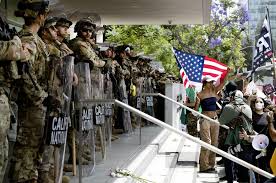US Appeals court backs Trump admin deploying National Guard troops to Los Angeles amid anti-immigration protests

In a landmark legal and political showdown, a federal appeals court has sided with former President Donald Trump in his decision to deploy National Guard troops to Los Angeles during a wave of anti-immigration protests. The ruling, issued on June 19 by a three-judge panel from the Ninth Circuit Court of Appeals, upholds Trump’s controversial move to federalize California’s National Guard—without the consent of Governor Gavin Newsom.
This is the first time since the 1960s that a U.S. president has taken control of a state’s National Guard over the objections of its governor, raising significant constitutional and legal questions about the balance of state and federal power in managing civil unrest.
Court Rules Trump Acted Within Legal Authority
The appellate court reversed a lower court’s earlier injunction that had temporarily blocked the Trump administration from exercising control over the Guard. The panel, which included two judges appointed by Trump and one by President Biden, ruled unanimously that the president’s actions fell within his statutory and constitutional authority.
According to the decision, federal agents and military officials provided “ample evidence” of violent protests in downtown Los Angeles. The court cited multiple incidents where federal officers were allegedly “trapped by demonstrators,” targeted by projectiles, and subject to threats of arson and looting.
“The President retains broad discretion to respond to domestic unrest, especially when federal assets are under threat,” wrote Chief Judge Maria Sandoval in the court’s opinion. “While this power is not absolute, the decision to federalize troops in this instance reflected a range of honest judgment.”
Background: Protests and Political Fallout
The legal dispute stems from the Trump administration’s response to nationwide protests sparked by a sweeping immigration bill passed by Congress in May. The law, which mandates stricter deportation proceedings and expanded federal detention powers, ignited demonstrations across major cities—particularly in California, where immigration issues are especially contentious.
In early June, thousands of protesters gathered in Los Angeles, clashing with police and occupying federal buildings. Although local authorities attempted to control the situation, the Trump White House declared a “public safety emergency” and invoked the Insurrection Act to take direct command of nearly 4,000 California National Guard troops.
Governor Newsom publicly objected to the decision, calling it a “clear abuse of executive power.” He filed an emergency lawsuit claiming the deployment was politically motivated and violated California’s sovereign authority.
Legal Debate: Who Controls the Guard?
At the heart of the case is a long-standing constitutional question: under what conditions can the President assume control of a state’s National Guard without the governor’s consent?
Traditionally, National Guard units operate under the dual authority of both state and federal governments. While governors typically oversee their use during local emergencies, the President has the power to federalize these forces under Title 10 of the U.S. Code in times of insurrection, invasion, or civil disorder.
The Ninth Circuit’s ruling emphasized that while this power must be exercised with caution, courts should not override executive decisions unless they are clearly unreasonable or violate fundamental rights.
“The judiciary is not a battlefield commander,” Judge Sandoval noted. “We are not empowered to substitute our policy preferences for lawful executive action grounded in factual evidence.”
What’s Next in the Legal Battle?
Although the appellate court’s decision is a major victory for the Trump legal team, the matter is far from settled. The case now returns to the lower district court for further proceedings, including a hearing on a possible preliminary injunction. California Attorney General Rob Bonta has also signaled plans to appeal the ruling to a full en banc review by the Ninth Circuit—and potentially to the U.S. Supreme Court.
“We remain committed to defending California’s autonomy against federal overreach,” Bonta said in a statement. “This case will set a precedent for how states and the federal government navigate emergency authority in the future.”
The case could also affect future presidential actions during unrest, especially if a similar legal challenge arises under a different administration.
Public Reaction: A Nation Divided
As expected, the ruling has sparked strong reactions across the political spectrum.
Former President Trump hailed the decision as a “BIG WIN for law and order,” claiming that the federal government must have the power to step in when state and local officials “fail to control chaos.”
“California was spiraling out of control,” Trump posted on Truth Social. “We acted decisively to protect lives and federal property. The courts got it right.”
In contrast, Governor Newsom condemned the ruling as a dangerous step toward authoritarianism. “This isn’t just about immigration or the National Guard,” he said at a press briefing. “It’s about whether a president can trample on states’ rights under the guise of public safety.”
Civil liberties groups have also voiced concern that the decision could open the door for future abuses of federal power.
Broader Implications
Beyond the immediate legal ramifications, this case has reignited debates over the militarization of domestic crisis management. Critics argue that deploying military forces to control protests sets a troubling precedent, especially in an era of increasing political polarization and protest movements.
Moreover, the timing—just months before the 2025 presidential election—adds a layer of political intrigue. With Trump expected to run again, his ability to assert strong executive authority over Democratic-led states could become a key campaign theme.
Conclusion
The Ninth Circuit’s ruling in favor of Trump marks a pivotal moment in American governance, reaffirming the president’s ability to deploy federal forces during periods of unrest. However, it also raises urgent questions about the limits of executive power, the role of federal courts, and the enduring tension between state autonomy and national authority.
As legal battles continue and political tensions simmer, the country remains divided—not only over immigration policy but also over who has the ultimate power to maintain public order in turbulent times.






